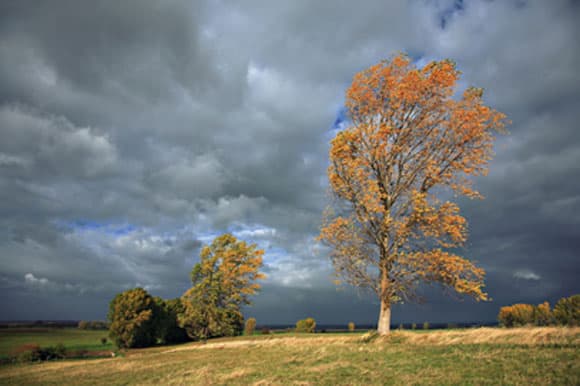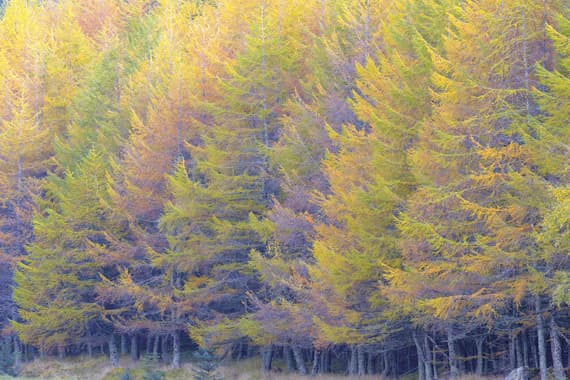
Woodlands offer great photo opportunities. This tree, near the Birks of Aberfeldy, Scotland, was shot with a Nikon D2x, 17-35mm f2.8 zoom
Autumn is unquestionably the most photogenic season of the year. It’s as if the beautiful colours and endless leafy carpets are nature’s way of compensating us for any sadness we may feel about the end of summer and the imminent onset of winter.
It’ll be upon us soon, so get ready to take advantage of the great but brief photo opportunities that autumn offers by learning how to take great Autumn landscape photos.
To give you some tips and ideas, we’ve got eight pages of advice from top UK landscape photographer Jeremy Walker, while resident Photoshop expert Philip Andrews shows us how we can improve our shots in post-production.
Autumn can be a wet and stormy season and this can be very photogenic. Here the classic rule of thirds has been used to good effect, with the two trees positioned on the vertical intersections and the horizon on the lower third.
Autumn Landscape photos: The wide view

By using an 80-200mm to crop in close, Jeremy has emphasised the pattern of colour in these fir trees.
The big autumnal view can be a hard image to capture if you haven’t the vast sweeping acreage of New England on your doorstep, but with a little bit of research and planning you should still be able to find suitable woods and forests somewhere in the UK.
There’s the New Forest, the Ashridge Estate, Birks of Aberfeldy to mention a few, and, although autumn colours are usually associated with deciduous trees, don’t overlook the potential of some types of pine and fir trees.
If you are going for the ‘big view‘ approach with a wideangle lens, try to include some foreground interest – a boulder, rock or smattering of colourful leaves, for instance – and don’t be afraid to go and collect a carrier bag full of leaves before carefully placing them in your shot.
Try composing your shot with something leading the eye into the main point of interest, such as a path, stream or stonewall. Another way of shooting the big view is to use a telephoto lens to isolate a point of interest, remembering to try to keep the composition as simple, neat and tidy as possible to lend eye-catching impact.
Autumn Landscape photos: Lighting and exposure
Different types of weather will give you different types of light, from the clear crisp light that follows a rainstorm to soft shadowless light that comes with mist and fog, with each type useable when shooting autumnal scenes.
Don’t dismiss dull overcast days as down time when you can’t shoot, as these conditions are perfect for shooting in woods and forests when you need to keep the contrast to a minimum and avoid big black shadows and stark highlights from bright sunlight.

Backlit leaves can make great photos, if exposed carefully. Here, Jeremy metered off the leaves to ensure a correct exposure for them while letting the potentially distracting background go almost black.
Don’t forget to look up as well as down for photo opportunities!
On the other hand, bright sunlight is great for backlighting leaves and making them radiate colour, especially if you frame them against a dark background. Try shooting with the light coming across your image at 90° to you, which will help bring out texture, shape and form.
Exposure control as always is very important; light readings with built-in meters on modern cameras are almost foolproof and the exposure latitude with digital is incredible, but you still have to be very careful to avoid burning out your highlights.
Check the histogram on the camera monitor to make sure you are within acceptable tolerances and, as a starting point, meter for the mid-tones. Not everything has to be shot at f/22 and at 1/500th of a second, so try shooting wide open and using a shallow depth of field for effect.
Think about using slow shutter speeds for blurred wind-blown leaves and branches – experimenting won’t cost anything. Such are the joys of shooting digitally.
Autumn Landscape photos: Top Tips

As with every other season, the best light for landscape photography usually occurs early in the morning or last thing in the evening – with or without a sunrise/sunset to enhance the colours in the sky. With pictures like this that include a lot of sky, be careful over metering. A Neutral Density graduated filter will balance the brightness levels between the sky and the darker foreground, so any sky detail can be preserved without underexposing the ground.
Keep it simple
Think about the essential elements within your image and omit anything which detracts from this.
Get up early
Catch the early morning light and you’ll be rewarded with a softer ambience to work with.
Use foreground interest
Think about what will give your image a sense of scale and dimension.
Think about composition
Don’t always place your subject in the middle of the frame – be imaginative!
Histogram
Use your camera’s histogram to check your image is correctly exposed.
Highlights
Keep an eye on these so that they don’t burn out and lose detail. Your histogram may flash to indicate where the image has been overexposed.
Filters
Use ND grads to balance the exposure between the foreground and the sky.
By Jeremy Walker







